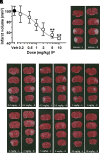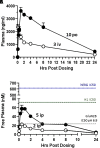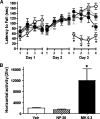A Glutamate N-Methyl-d-Aspartate (NMDA) Receptor Subunit 2B-Selective Inhibitor of NMDA Receptor Function with Enhanced Potency at Acidic pH and Oral Bioavailability for Clinical Use
- PMID: 34493631
- PMCID: PMC8626636
- DOI: 10.1124/jpet.120.000370
A Glutamate N-Methyl-d-Aspartate (NMDA) Receptor Subunit 2B-Selective Inhibitor of NMDA Receptor Function with Enhanced Potency at Acidic pH and Oral Bioavailability for Clinical Use
Abstract
We describe a clinical candidate molecule from a new series of glutamate N-methyl-d-aspartate receptor subunit 2B-selective inhibitors that shows enhanced inhibition at extracellular acidic pH values relative to physiologic pH. This property should render these compounds more effective inhibitors of N-methyl-d-aspartate receptors at synapses responding to a high frequency of action potentials, since glutamate-containing vesicles are acidic within their lumen. In addition, acidification of penumbral regions around ischemic tissue should also enhance selective drug action for improved neuroprotection. The aryl piperazine we describe here shows strong neuroprotective actions with minimal side effects in preclinical studies. The clinical candidate molecule NP10679 has high oral bioavailability with good brain penetration and is suitable for both intravenous and oral dosing for therapeutic use in humans. SIGNIFICANCE STATEMENT: This study identifies a new series of glutamate N-methyl-d-aspartate (NMDA) receptor subunit 2B-selective negative allosteric modulators with properties appropriate for clinical advancement. The compounds are more potent at acidic pH, associated with ischemic tissue, and this property should increase the therapeutic safety of this class by improving efficacy in affected tissue while sparing NMDA receptor block in healthy brain.
Copyright © 2021 by The American Society for Pharmacology and Experimental Therapeutics.
Figures




Similar articles
-
Phase 1 Clinical Results for NP10679, a pH-sensitive GluN2B-selective N-methyl-d-aspartate Receptor Inhibitor.Clin Pharmacol Drug Dev. 2023 Jul;12(7):706-717. doi: 10.1002/cpdd.1217. Epub 2023 Jan 15. Clin Pharmacol Drug Dev. 2023. PMID: 36642931 Free PMC article. Clinical Trial.
-
Structure-activity analysis of a novel NR2C/NR2D-preferring NMDA receptor antagonist: 1-(phenanthrene-2-carbonyl) piperazine-2,3-dicarboxylic acid.Br J Pharmacol. 2004 Feb;141(3):508-16. doi: 10.1038/sj.bjp.0705644. Epub 2004 Jan 12. Br J Pharmacol. 2004. PMID: 14718249 Free PMC article.
-
Clinical development of the GluN2B-selective NMDA receptor inhibitor NP10679 for the treatment of neurologic deficit after subarachnoid hemorrhage.J Pharmacol Exp Ther. 2025 Jan;392(1):100046. doi: 10.1124/jpet.124.002334. Epub 2024 Nov 26. J Pharmacol Exp Ther. 2025. PMID: 39892986
-
Antagonists selective for NMDA receptors containing the NR2B subunit.Curr Pharm Des. 1999 May;5(5):381-404. Curr Pharm Des. 1999. PMID: 10213801 Review.
-
NMDA/NR2B selective antagonists in the treatment of ischemic brain injury.Curr Drug Targets CNS Neurol Disord. 2005 Apr;4(2):143-51. doi: 10.2174/1568007053544183. Curr Drug Targets CNS Neurol Disord. 2005. PMID: 15857299 Review.
Cited by
-
Selective Enhancement of the Interneuron Network and Gamma-Band Power via GluN2C/GluN2D NMDA Receptor Potentiation.bioRxiv [Preprint]. 2024 Nov 5:2024.11.05.622179. doi: 10.1101/2024.11.05.622179. bioRxiv. 2024. Update in: J Physiol. 2025 Jul;603(14):4027-4049. doi: 10.1113/JP288343. PMID: 39574703 Free PMC article. Updated. Preprint.
-
Evaluation of (rac)-, (R)-, and (S)-18F-OF-NB1 for Imaging GluN2B Subunit-Containing N-Methyl-d-Aspartate Receptors in Nonhuman Primates.J Nucl Med. 2022 Dec;63(12):1912-1918. doi: 10.2967/jnumed.122.263977. Epub 2022 Jun 16. J Nucl Med. 2022. PMID: 35710735 Free PMC article.
-
Phase 1 Clinical Results for NP10679, a pH-sensitive GluN2B-selective N-methyl-d-aspartate Receptor Inhibitor.Clin Pharmacol Drug Dev. 2023 Jul;12(7):706-717. doi: 10.1002/cpdd.1217. Epub 2023 Jan 15. Clin Pharmacol Drug Dev. 2023. PMID: 36642931 Free PMC article. Clinical Trial.
-
Structure, Function, and Pharmacology of Glutamate Receptor Ion Channels.Pharmacol Rev. 2021 Oct;73(4):298-487. doi: 10.1124/pharmrev.120.000131. Pharmacol Rev. 2021. PMID: 34753794 Free PMC article. Review.
-
Targeting NMDA Receptors at the Neurovascular Unit: Past and Future Treatments for Central Nervous System Diseases.Int J Mol Sci. 2022 Sep 7;23(18):10336. doi: 10.3390/ijms231810336. Int J Mol Sci. 2022. PMID: 36142247 Free PMC article. Review.
References
-
- Abe TMatsumura SKatano TMabuchi TTakagi KXu LYamamoto AHattori KYagi TWatanabe M, et al. (2005) Fyn kinase-mediated phosphorylation of NMDA receptor NR2B subunit at Tyr1472 is essential for maintenance of neuropathic pain. Eur J Neurosci 22:1445–1454. - PubMed
-
- Addy C, Assaid C, Hreniuk D, Stroh M, Xu Y, Herring WJ, Ellenbogen A, Jinnah HA, Kirby L, Leibowitz MT, et al. (2009) Single-dose administration of MK-0657, an NR2B-selective NMDA antagonist, does not result in clinically meaningful improvement in motor function in patients with moderate Parkinson’s disease. J Clin Pharmacol 49:856–864. - PubMed
-
- Albers GW, Goldstein LB, Hall D, Lesko LM; Aptiganel Acute Stroke Investigators (2001) Aptiganel hydrochloride in acute ischemic stroke: a randomized controlled trial. JAMA 286:2673–2682. - PubMed
Publication types
MeSH terms
Substances
Grants and funding
LinkOut - more resources
Full Text Sources

